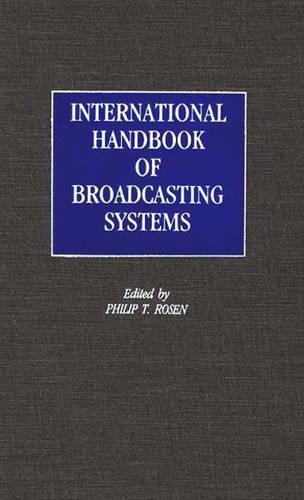
International Handbook of Broadcasting Systems
(Hardback)
Publishing Details
International Handbook of Broadcasting Systems
By (Author) Philip T. Rosen
Bloomsbury Publishing PLC
Greenwood Press
23rd May 1988
United States
Classifications
Tertiary Education
Non Fiction
384
Physical Properties
Hardback
326
Description
This work treats an important segment of international communications, a rapidly growing area of scholarly and practical interest. Rosen has brought together survey essays on the major forces in world broadcasting. The contributors are either communication scholars witnessing the industry from within the country of which they write, or are students of international communication in American universities. Each essay covers the history of radio and television, government regulation policies and issues, economic structure of the industry, broadcast reform and alternative structures, new technologies, and a forecast. The writing is concise and the material informative. Choice The Basis for Goal Setting The Goal-Setting Model Performance, Rewards, and SatisfactionCulture, Power, and Goal Setting Finding the Right Organizational Fit Organizational Goal Setting Strategic Management The Strategic-Planning Process Implementation (Execution) Team GoalsTeam Characteristics Team Leadership Building Teams B Individual Goal Setting Individual Needs, Motives, and Subconscious Values Goal-Setting: A System of Inducing Commitment Guidelines for Setting Goals and Objectives Information Management and Goal Setting Information and Goal Setting: An Overview Information Management: Organizations, Teams, and Individuals Change and Goal Setting Renewal and Change Teamwork and Change Individual Empowerment Results Attaining
Reviews
"This resource for students, scholars, and practitioners in the field of international broadcasting covers nations that represent various regions and continents, political systems, and cultural traditions. Each selection examines the history of radio and television, government regulation, economic structure, programming, broadcasting reform and alternative structures, and new technologies. The editor's introduction provides an overview of changes in the broadcasting industry and points to the intrusive proliferation of technology [that] threatens to homogenize' its audience into a marketplace for mass entertainment and consumption."-Journal of Communication
This resource for students, scholars, and practitioners in the field of international broadcasting covers nations that represent various regions and continents, political systems, and cultural traditions. Each selection examines the history of radio and television, government regulation, economic structure, programming, broadcasting reform and alternative structures, and new technologies. The editor's introduction provides an overview of changes in the broadcasting industry and points to the intrusive proliferation of technology [that] threatens to homogenize' its audience into a marketplace for mass entertainment and consumption.-Journal of Communication
This work treats an important segment of international communications, a rapidly growing area of scholarly and practical interest. Rosen has brought together survey essays on the major forces in world broadcasting....The writing is concise and the material informative. Bibliographies are included. Recommended for collections that serve programs in journalism and mass communication research.-Choice
"This work treats an important segment of international communications, a rapidly growing area of scholarly and practical interest. Rosen has brought together survey essays on the major forces in world broadcasting....The writing is concise and the material informative. Bibliographies are included. Recommended for collections that serve programs in journalism and mass communication research."-Choice
Author Bio
PHILIP T. ROSEN is on the faculty at the Art Institute of Fort Lauderdale.
